Showing Spotlights 545 - 552 of 2784 in category All (newest first):
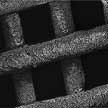 MXenes are a promising class of 2D materials with unique intrinsic physical and chemical properties, including excellent conductivity, hydrophilicity and high density when compared to graphene. 3D-printed architectures composed of MXenes are particularly attractive for energy storage applications such as rechargeable lithium- and sodium-ion batteries, lithium-sulfur batteries and supercapacitors. Researchers now have demonstrated for the first time the possibility to print three-dimensional freestanding MXene objects.
MXenes are a promising class of 2D materials with unique intrinsic physical and chemical properties, including excellent conductivity, hydrophilicity and high density when compared to graphene. 3D-printed architectures composed of MXenes are particularly attractive for energy storage applications such as rechargeable lithium- and sodium-ion batteries, lithium-sulfur batteries and supercapacitors. Researchers now have demonstrated for the first time the possibility to print three-dimensional freestanding MXene objects.
Aug 6th, 2019
 Researchers have fabricated textiles that can protect you from rain, stains, and bacteria, while they harvest the biomechanical energy of the user to power textile-based electronics. These omniphobic triboelectric nanogenerators can be incorporated into any fiber-based textile and be used to power wearable devices using energy harvested from human motion. The team also designed their nanogenerators with large-scale fabrication runs in mind, using embroidery as a technique compatible with conventional textile manufacturing techniques.
Researchers have fabricated textiles that can protect you from rain, stains, and bacteria, while they harvest the biomechanical energy of the user to power textile-based electronics. These omniphobic triboelectric nanogenerators can be incorporated into any fiber-based textile and be used to power wearable devices using energy harvested from human motion. The team also designed their nanogenerators with large-scale fabrication runs in mind, using embroidery as a technique compatible with conventional textile manufacturing techniques.
Jul 31st, 2019
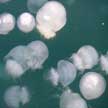 Researchers demonstrate the ease of use of jellyfish biomass as a biodegradable and biocompatible raw material for producing antibacterial mats. They report the successful electrospun-based preparation of novel composite biocompatible nanofibers based on jellyfish biomass. The antibacterial properties of the resulting nanofiber mats were enhanced by incorporating silver nanoparticles within applying an in situ bio-template synthesis that the team developed. This work suggests exploiting the jellyfish as an accessible, cheap and valuable renewable material that can be used in various applications, such as cosmetics, wound dressings, artificial skin, and bioplastics.
Researchers demonstrate the ease of use of jellyfish biomass as a biodegradable and biocompatible raw material for producing antibacterial mats. They report the successful electrospun-based preparation of novel composite biocompatible nanofibers based on jellyfish biomass. The antibacterial properties of the resulting nanofiber mats were enhanced by incorporating silver nanoparticles within applying an in situ bio-template synthesis that the team developed. This work suggests exploiting the jellyfish as an accessible, cheap and valuable renewable material that can be used in various applications, such as cosmetics, wound dressings, artificial skin, and bioplastics.
Jul 30th, 2019
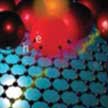 Among 2D materials, graphene is considered as one of the important components in many van der Waals (vdWs) heterostructure assemblies due to its high carrier mobility, good environmental stability, tunable work function, and mature processing technique. Besides the contact between different 2D atomic layers, the passivated, dangling-bond-free surfaces of 2D crystals can bond together with other dimensional materials through vdWs force. Consequently, fabrication of mixed-dimensional vdWs heterostructures could be carried out through hybridizing 2D crystals with 0D dots or particles, 1D nanostructures, or 3D bulk materials.
Among 2D materials, graphene is considered as one of the important components in many van der Waals (vdWs) heterostructure assemblies due to its high carrier mobility, good environmental stability, tunable work function, and mature processing technique. Besides the contact between different 2D atomic layers, the passivated, dangling-bond-free surfaces of 2D crystals can bond together with other dimensional materials through vdWs force. Consequently, fabrication of mixed-dimensional vdWs heterostructures could be carried out through hybridizing 2D crystals with 0D dots or particles, 1D nanostructures, or 3D bulk materials.
Jul 29th, 2019
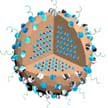 Researchers have for the first time proposed a novel tumor treatment strategy for microwave dynamic therapy to effectively treat cancers. This technique can promote the efficacy of dynamic treatment of deep tumors in clinical research and could have a broad range of applications. The team found that liquid metal supernanoparticles can generate reactive oxygen species (ROS) under microwave irradiation. That makes them suitable as microwave sensitizers for revolutionizing the ROS generation techniques.
Researchers have for the first time proposed a novel tumor treatment strategy for microwave dynamic therapy to effectively treat cancers. This technique can promote the efficacy of dynamic treatment of deep tumors in clinical research and could have a broad range of applications. The team found that liquid metal supernanoparticles can generate reactive oxygen species (ROS) under microwave irradiation. That makes them suitable as microwave sensitizers for revolutionizing the ROS generation techniques.
Jul 25th, 2019
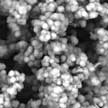 Carbon nano-onions (CNOs), a less studied morphology of carbon nanomaterials, are exotic structures with extraordinary properties and numerous applications. These applications have been largely ignored due to their high synthesis cost. Researchers now have produced inexpensive, stable carbon-nano onions directly from carbon dioxide. The carbon dioxide reactant replaces nano-diamonds as the reactant to form the nano-onions. The source of CO2 to produce these CNOs can be the consumption of industrial flue gas or CO2 directly captured from the air.
Carbon nano-onions (CNOs), a less studied morphology of carbon nanomaterials, are exotic structures with extraordinary properties and numerous applications. These applications have been largely ignored due to their high synthesis cost. Researchers now have produced inexpensive, stable carbon-nano onions directly from carbon dioxide. The carbon dioxide reactant replaces nano-diamonds as the reactant to form the nano-onions. The source of CO2 to produce these CNOs can be the consumption of industrial flue gas or CO2 directly captured from the air.
Jul 19th, 2019
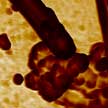 Turmeric has a long history of usage in traditional medicine in India and China. Ancient Indians have known the medicinal properties of turmeric - i.e. curcumin - for several millennia. Researchers have now investigated the antibacterial effects of curcumin loaded into halloysite nanotubes and found that this nanoformulation drastically increased the life expectancy of nematodes infected by pathogenic bacteria. The most interesting finding here is the selective antimicrobial action of curcumin, which suppressed one bacterial species, while demonstrating no adverse effect on another.
Turmeric has a long history of usage in traditional medicine in India and China. Ancient Indians have known the medicinal properties of turmeric - i.e. curcumin - for several millennia. Researchers have now investigated the antibacterial effects of curcumin loaded into halloysite nanotubes and found that this nanoformulation drastically increased the life expectancy of nematodes infected by pathogenic bacteria. The most interesting finding here is the selective antimicrobial action of curcumin, which suppressed one bacterial species, while demonstrating no adverse effect on another.
Jul 15th, 2019
 The recent interest of nanotechnology researchers in liquid metals is based on the properties that differentiate them from common liquids such as water or organics. In addition to their chemical reactivity, the electronic behavior of these liquids, combined with the strong interatomic interactions throughout the bulk, lead to liquids with high densities, thermal and electrical conductivities, and optical reflectivity (over a wide range of wavelengths). This offers potential new approaches for the synthesis of nanomaterials and investigations of fundamental physics and chemistry at small length scales.
The recent interest of nanotechnology researchers in liquid metals is based on the properties that differentiate them from common liquids such as water or organics. In addition to their chemical reactivity, the electronic behavior of these liquids, combined with the strong interatomic interactions throughout the bulk, lead to liquids with high densities, thermal and electrical conductivities, and optical reflectivity (over a wide range of wavelengths). This offers potential new approaches for the synthesis of nanomaterials and investigations of fundamental physics and chemistry at small length scales.
Jul 11th, 2019
 MXenes are a promising class of 2D materials with unique intrinsic physical and chemical properties, including excellent conductivity, hydrophilicity and high density when compared to graphene. 3D-printed architectures composed of MXenes are particularly attractive for energy storage applications such as rechargeable lithium- and sodium-ion batteries, lithium-sulfur batteries and supercapacitors. Researchers now have demonstrated for the first time the possibility to print three-dimensional freestanding MXene objects.
MXenes are a promising class of 2D materials with unique intrinsic physical and chemical properties, including excellent conductivity, hydrophilicity and high density when compared to graphene. 3D-printed architectures composed of MXenes are particularly attractive for energy storage applications such as rechargeable lithium- and sodium-ion batteries, lithium-sulfur batteries and supercapacitors. Researchers now have demonstrated for the first time the possibility to print three-dimensional freestanding MXene objects.
 Subscribe to our Nanotechnology Spotlight feed
Subscribe to our Nanotechnology Spotlight feed





